
Sustainability Strategies in the Amazon - Gisele Ferreira de Araujo
Sustainability Strategies in the Amazon: A Comprehensive Guide to Preserving the World's Largest Rainforest
Introduction
The Amazon rainforest is the largest rainforest in the world, covering an area of over 5.5 million square kilometers. It is home to an estimated 10% of the world's known species, and plays a vital role in regulating the global climate. However, the Amazon is under threat from deforestation, climate change, and other human activities.
The Importance of the Amazon Rainforest
The Amazon rainforest provides a number of important ecosystem services, including:
- Climate regulation: The Amazon rainforest helps to regulate the global climate by absorbing carbon dioxide from the atmosphere and releasing oxygen. It also plays a role in regulating rainfall patterns and preventing droughts.
- Biodiversity: The Amazon rainforest is home to an estimated 10% of the world's known species. This includes a wide variety of plants, animals, and insects, many of which are found nowhere else on Earth.
- Water filtration: The Amazon rainforest helps to filter water and provide clean drinking water for millions of people. It also helps to prevent soil erosion and flooding.
- Economic benefits: The Amazon rainforest provides a number of economic benefits, including tourism, timber, and agriculture. It is also a source of traditional medicines and other natural products.
Threats to the Amazon Rainforest
The Amazon rainforest is under threat from a number of human activities, including:
- Deforestation: Deforestation is the clearing of forests for other uses, such as agriculture, logging, and mining. Deforestation is the biggest threat to the Amazon rainforest, and it is estimated that over 17% of the rainforest has been cleared since 1970.
- Climate change: Climate change is causing the Amazon rainforest to become warmer and drier. This is leading to changes in the rainforest's ecosystem, including the loss of plant and animal species.
- Pollution: Pollution from human activities, such as mining, logging, and agriculture, is also a threat to the Amazon rainforest. Pollution can contaminate the rainforest's water and soil, and it can also harm plants and animals.
Sustainability Strategies for the Amazon Rainforest
There are a number of things that can be done to protect the Amazon rainforest, including:
- Reducing deforestation: Reducing deforestation is the most important thing that can be done to protect the Amazon rainforest. This can be done by promoting sustainable agriculture, reducing the demand for timber and other forest products, and increasing law enforcement to prevent illegal logging.
- Addressing climate change: Addressing climate change is also essential for protecting the Amazon rainforest. This can be done by reducing greenhouse gas emissions, investing in renewable energy, and promoting climate adaptation measures.
- Reducing pollution: Reducing pollution from human activities is also important for protecting the Amazon rainforest. This can be done by improving waste management, reducing the use of pesticides and fertilizers, and promoting sustainable agriculture.
Conclusion
The Amazon rainforest is a vital part of the global ecosystem, and it is under threat from a number of human activities. However, there are a number of things that can be done to protect the rainforest, including reducing deforestation, addressing climate change, and reducing pollution. By working together, we can ensure that the Amazon rainforest continues to thrive for generations to come.
Call to Action
If you are interested in learning more about the Amazon rainforest and how you can help to protect it, there are a number of resources available online. You can also support organizations that are working to protect the rainforest, such as the Amazon Conservation Association, the Rainforest Alliance, and the World Wildlife Fund.